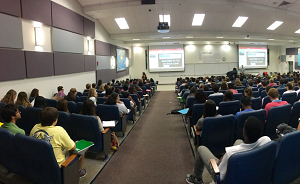This summer and fall have been filled with attacks on charter schooling, for-profit schools and colleges, and any reform deemed to feel too business’ish. At one level, this isn’t shocking. Education has long been rife with suspicion of ideas that seem too “businesslike.” The very term “productivity” can set teeth on edge. It shouldn’t, however, as Bror Saxberg and I have discussed in Breakthrough Leadership in the Digital Age.
 There’s a misleading sense that “productivity” is somehow at odds with nurturing students or valuing teachers. That’s just not so. Making “productive” use of teachers, time, and money is nothing more than ensuring that schools are promoting great teaching and learning to the best of their ability. Whether this means providing more learning time, coaching, arts instruction, or anything else is a determination that will be made by educators, parents, and public officials. But productivity itself simply means being able to do more good for more kids.
There’s a misleading sense that “productivity” is somehow at odds with nurturing students or valuing teachers. That’s just not so. Making “productive” use of teachers, time, and money is nothing more than ensuring that schools are promoting great teaching and learning to the best of their ability. Whether this means providing more learning time, coaching, arts instruction, or anything else is a determination that will be made by educators, parents, and public officials. But productivity itself simply means being able to do more good for more kids.
Skepticism about “productivity” is sometimes coupled with doubts about the value of new technologies. As the late Senator Daniel Patrick Moynihan famously remarked, producing a Mozart quartet two centuries ago required four musicians, four stringed instruments, and, say, 35 minutes. Producing the same Mozart quartet today, he said, requires the same resources.
Moynihan’s analogy, while correct, is ultimately misleading when applied to schooling. In the arts, what has changed over two centuries is that radio, CDs, television, and digital media have profoundly increased the number of people able to hear and appreciate a given performance—at an ever-decreasing cost. New technology has made available to the general public a pretty fair stand-in for what was once the preserve of the elite. Maybe listening to a digital recording of the Boston Pops on a good sound system isn’t at the same level as seeing them in person in your white tails, but it’s a whole lot more convenient, accessible, and affordable, and it offers a passable version of the experience to millions who would have otherwise never been able to experience the original.
This is part of technology’s promise, and where technology becomes so integral to productivity. If pop stars could only play for a hundred club-goers at a time, they’d be hard-pressed to reach 50,000 listeners a year, even if they played all 365 nights. However, playing to stadiums with the aid of technology to amplify the sound and the visuals, that same singer can play to 50,000 in a single night. Playing stadiums and sharing songs via online downloads makes cheaply available to billions what used to be the province of a fortunate few.
Is hearing Lady Gaga in a stadium as “good” an experience as hearing her play in a club? Probably not. But, as with the book, it offers the experience to those who otherwise wouldn’t… you get the idea. Oh, and if Lady Gaga had to work forty hours a week waiting tables or writing computer code in order to keep a roof over her head (because she couldn’t make a living playing clubs), she wouldn’t have as much time to practice, craft new routines, or cut songs.
In other words, the technology-aided experience allows skilled professionals to earn outsized recognition, influence, and compensation. In schooling, technologies today offer the promise of extending the impact of the instruction, tutoring, and mentoring of a terrific teacher so that she can coach, tutor, or instruct hundreds with the same energy she once expended reaching only five or twenty-five. That’s productivity. Can such opportunities be designed or employed poorly? Of course. But the underlying logic is brimming with possibility for teachers and students.
Cathy Davidson, author of Now You See It: How the Brain Science of Attention Will Transform the Way We Live, Work, and Learn, encourages us to ask: “What is happening in the classroom that could not be duplicated by a computer?” She observes, “If the answer is ‘nothing,’ then there is a problem. In fact, I believe that if teachers can be replaced by computers, they should be. By that I mean if a teacher offers nothing that [a] child can’t get from a computer screen, then your child might as well be learning online. On the other hand, no screen will ever replace a creative, engaged, interactive, relevant, and inspiring teacher, especially one who takes advantage of the precious face-to-face experience of people learning together.”
That’s the right way to think about productivity. In fact, technology and productivity should allow us to have more students spending more time engaging more intensely with just those teachers. It’s hard for me to see the downside in that.
– Frederick Hess
This first appeared on Rick Hess Straight Up.


